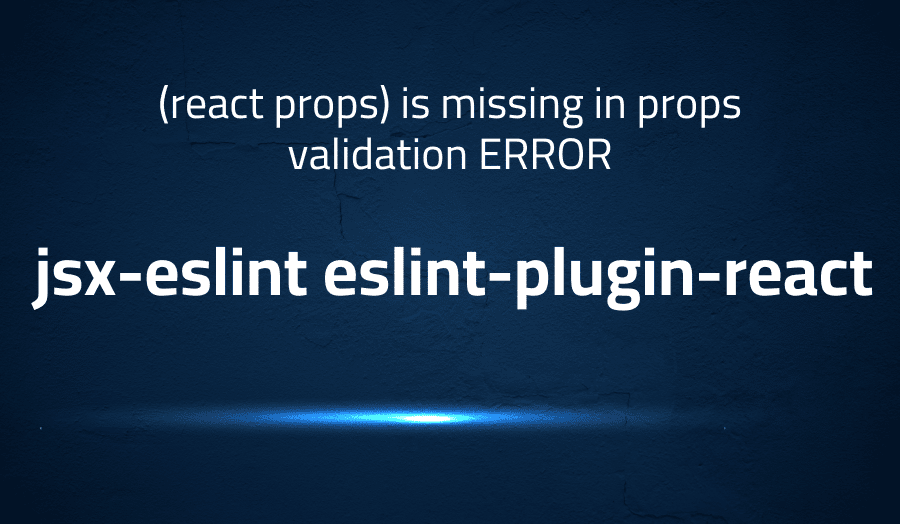

(react props) is missing in props validation ERROR in jsx-eslint eslint-plugin-react
Explanation of the problem
When testing version 7.20.6 of a Next.js project, an error was encountered indicating that a prop was missing from the validation. The developer is now attempting to add linting to the project using a set of dependencies that include eslint, eslint-config-airbnb-typescript, eslint-config-prettier, eslint-plugin-import, eslint-plugin-jsx-a11y, eslint-plugin-prettier, eslint-plugin-react, and eslint-plugin-react-hooks. However, when attempting to lint the project’s components, the developer continues to encounter the error indicating a missing prop.
The project’s eslint configuration file contains environment settings for the browser and ECMAScript 2020, as well as a set of rules for linting the codebase. The configuration extends the airbnb-typescript, prettier, and plugin:prettier/recommended configurations, while using the @typescript-eslint/parser and @typescript-eslint/recommended plugins. Rules have been set for prettier formatting, the usage of default exports, nested ternaries, and naming conventions, among other things. Despite these configurations, the error regarding missing props validation continues to be thrown on multiple components.
Troubleshooting with the Lightrun Developer Observability Platform
Getting a sense of what’s actually happening inside a live application is a frustrating experience, one that relies mostly on querying and observing whatever logs were written during development.
Lightrun is a Developer Observability Platform, allowing developers to add telemetry to live applications in real-time, on-demand, and right from the IDE.
- Instantly add logs to, set metrics in, and take snapshots of live applications
- Insights delivered straight to your IDE or CLI
- Works where you do: dev, QA, staging, CI/CD, and production
Start for free today
Problem solution for (react props) is missing in props validation ERROR in jsx-eslint eslint-plugin-react
When using ESLint with the eslint-plugin-react plugin in a React project, you might encounter the error “Problem solution for (react props) is missing in props validation” when defining props validation rules.
This error indicates that a prop type is defined but not validated in the propTypes object of a component.
To resolve this error, you need to add a prop type validation for the missing prop in the propTypes object of your component. Here’s an example:
import React from 'react';
import PropTypes from 'prop-types';
function MyComponent(props) {
const { myProp } = props;
return <div>{myProp}</div>;
}
MyComponent.propTypes = {
myProp: PropTypes.string.isRequired, // Add the missing prop type validation
};
export default MyComponent;
In this example, the myProp prop is defined and used in the component, but its type is not validated in the propTypes object. To fix the error, we added a prop type validation using PropTypes.string.isRequired.
You should also make sure that you have imported PropTypes from the prop-types package, as it’s not included in React anymore starting from version 15.5.
Once you add the missing prop type validation, the error should disappear.
Other popular problems with jsx-eslint eslint-plugin-react
Problem: “Expected an assignment or function call and instead saw an expression” error
This error occurs when using jsx-eslint eslint-plugin-react to validate your JSX code, and it usually means that you have a JSX expression that is not being assigned or used as a function call. For example, the following code would produce this error:
const MyComponent = () => {
return <div>{props.text}</div> // error: Expected an assignment or function call and instead saw an expression
};
Solution:
To fix this error, you can either assign the JSX expression to a variable or use it as a function call, like this:
const MyComponent = (props) => {
const myText = <div>{props.text}</div>; // assign the JSX expression to a variable
return myText;
};
Problem: “Prop type is invalid” error
This error occurs when using jsx-eslint eslint-plugin-react to validate the prop types of a React component, and it usually means that you have defined a prop type that is not valid. For example, the following code would produce this error:
const MyComponent = ({ text }) => {
return <div>{text}</div>;
};
MyComponent.propTypes = {
text: React.PropTypes.string // error: Prop type `string` is invalid
};
Solution:
To fix this error, you should use the PropTypes object from the prop-types package to define valid prop types, like this:
import PropTypes from 'prop-types';
const MyComponent = ({ text }) => {
return <div>{text}</div>;
};
MyComponent.propTypes = {
text: PropTypes.string // use the PropTypes object to define valid prop types
};
Make sure to import PropTypes from the prop-types package and use it instead of React.PropTypes, as the latter is no longer supported in recent versions of React.
Problem: “Warning: Each child in a list should have a unique ‘key’ prop” warning
This warning occurs when using jsx-eslint eslint-plugin-react to validate your JSX code, and it usually means that you have a list of elements that are missing the key prop. For example, the following code would produce this warning:
const MyComponent = ({ items }) => {
return (
<ul>
{items.map(item => (
<li>{item}</li> // warning: Each child in a list should have a unique 'key' prop
))}
</ul>
);
};
Solution:
To fix this warning, you should add a key prop to each element in the list that has a unique value. For example, you could use the index of the element as the key, like this:
const MyComponent = ({ items }) => {
return (
<ul>
{items.map((item, index) => (
<li key={index}>{item}</li> // add a unique key prop to each element in the list
))}
</ul>
);
};
Make sure to use a unique value for the key prop, such as an ID or a hash, instead of the index of the element if possible,
A brief introduction to jsx-eslint eslint-plugin-react
jsx-eslint eslint-plugin-react is a plugin for ESLint that provides linting rules for React code written in JSX syntax. It includes rules for enforcing best practices and catching common mistakes, such as missing prop types, unused variables, and invalid JSX expressions. The plugin uses the react parser from @babel/eslint-parser to parse JSX syntax and extract information about React components and their props.
The jsx-eslint eslint-plugin-react plugin includes a wide range of rules, divided into categories such as base, hooks, jsx-a11y, react-hooks, and react. Each rule can be enabled or disabled individually, or you can use one of the predefined configurations, such as recommended or strict, to enforce a common set of rules. The plugin also supports configuration options for customizing the behavior of the rules, such as the allowed props for certain elements or the severity of the reported issues. By using jsx-eslint eslint-plugin-react in your project, you can ensure that your React code follows best practices, is easy to maintain, and is accessible to all users.
Most popular use cases for jsx-eslint eslint-plugin-react
- Enforcing code quality and best practices:
jsx-eslint eslint-plugin-reactcan be used to enforce code quality and best practices in React applications. By running the plugin on your code, you can catch common mistakes and enforce guidelines such as prop type validation, component naming conventions, and accessibility requirements. For example, the following code block would produce a warning because thealtprop is missing from theimgelement:
const MyComponent = ({ imageUrl }) => {
return <img src={imageUrl} />;
};
MyComponent.propTypes = {
imageUrl: PropTypes.string.isRequired,
};
By using jsx-eslint eslint-plugin-react, you can ensure that your code meets these requirements and is of high quality.
- Automating common development tasks:
jsx-eslint eslint-plugin-reactcan also be used to automate common development tasks, such as formatting and linting code. By using the plugin with a tool likeprettier, you can automatically format your code to follow consistent style guidelines. Similarly, by using the plugin witheslint, you can enforce linting rules that catch common errors and improve the readability and maintainability of your code. - Integrating with CI/CD pipelines:
jsx-eslint eslint-plugin-reactcan be integrated into CI/CD pipelines to catch errors and ensure code quality as part of the development process. By using the plugin in combination with tools likeJenkins,Travis CI, orGitHub Actions, you can automatically validate your code and catch issues before they make it to production. This can save time and reduce the risk of errors that can cause downtime or other issues for your users.
It’s Really not that Complicated.
You can actually understand what’s going on inside your live applications.




